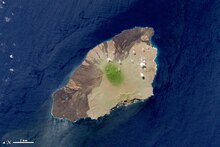Pinta Island
Map of the Galápagos Islands, with Pinta Island in the northwest. | |
| Geography | |
|---|---|
| Location | Galápagos Islands, Ecuador |
| Coordinates | 0°35′14″N 90°45′44″W / 0.587252°N 90.762184°W |
| Archipelago | Galápagos Islands |
| Administration | |
| Province | Galápagos Province |
| Canton | Santa Cruz |
Pinta Island (Spanish: Isla Pinta), also known as Abingdon Island, after the Earl of Abingdon, is an island located in the Galápagos Islands group, Ecuador. It has an area of 60 km2 (23 sq mi) and a maximum altitude of 777 metres (2,549 ft).[1]
Pinta was the original home to Lonesome George, perhaps the most famous tortoise in the Galápagos Islands. He was the last known representative of the subspecies Chelonoidis nigra abingdonii.

Pinta Island is also home to swallow-tailed gulls, marine iguanas, Galapagos hawks, Galapagos fur seals and a number of other birds and mammals.[citation needed] The most northern major island in the Galápagos, at one time Isla Pinta had a thriving tortoise population. The island's vegetation was devastated over several decades by introduced feral goats, thus diminishing food supplies for the native tortoises. A prolonged effort to exterminate goats introduced to Pinta was completed in 1990, and the vegetation of the island is starting to return to its former state.
The elongated island of Pinta is the northernmost of the active Galápagos volcanoes. Pinta is a shield volcano with an extensive underwater footprint originating from NNW-trending fissures.[2]
On January 28, 2008, Galápagos National Park official Victor Carrion announced the killing of 53 sea lions (13 pups, 25 youngsters, 9 males and 6 females) at Pinta, Galápagos Islands nature reserve with their heads caved in. In 2001 poachers killed 35 male sea lions. These acts were done for the initiative of the Project Isabela of removing the archipielago's introduced species.[3]
See also
References
- ^ Rocchio, Laura; Allen, J.; Simmon, R.; Taylor, M. (July 21, 2012). "Pinta Island". Earth Observatory: Images. EOS Project Science Office, NASA Godard Space Flight Center. Retrieved June 17, 2013.
- ^ Schlitzer, W.; Harpp, K.S.; Mittelstaedt, E.L.; Kurz, M.D.; Geist, D. (2011). The Effect of Lithospheric Discontinuities on the Composition of Lavas From the Northern Galápagos Platform Extension. American Geophysical Union, Fall Meeting 2011. Bibcode:2011agufmdi13a2141s.
- ^ "Sea lions massacred in Galápagos". BBC News. January 29, 2008. Retrieved June 17, 2013.

